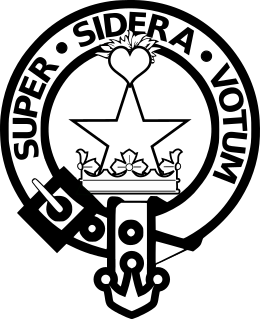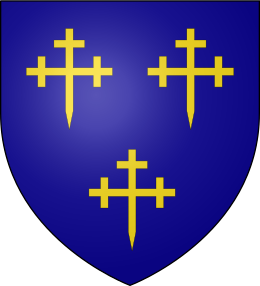Clan Rattray facts for kids
Quick facts for kids Clan Rattray |
|||
|---|---|---|---|
 |
|||
| Motto | Super sidera votum (My wishes are above the stars) | ||
| Chief | |||
 |
|||
| Alexander Rattray | |||
| of Rattray | |||
| Seat | Craighall | ||
| Historic seat | Rattray Castle | ||
|
|||
|
|||
Clan Rattray is an old and proud Scottish clan from the Highlands of Scotland. The Rattray family has a long and interesting history, with their name coming from a special place in Scotland.
Contents
History of Clan Rattray
Where the Clan Began
The Rattray family name comes from a place called Rattray in Perthshire, Scotland. They have lived there for a very long time, possibly since 307 AD! The word 'Rattray' comes from old Gaelic and Cymric words meaning 'hill fort'. This shows that their home was once a strong, fortified place.
Fighting for Scotland's Freedom
During the Wars of Scottish Independence, a Rattray named Eustace was captured. This happened at the Battle of Dunbar (1296), and he was taken to England as a prisoner.
Later, Eustace's son, Adam Rattray, promised loyalty to Edward I of England in 1296. But his son, Alexander Rattray, was part of a meeting in Ayr in 1315. This meeting was to decide who would be the next king of Scotland.
Alexander's brother, Eustace, was later accused of trying to remove Robert the Bruce from power. However, he was found innocent.
Challenges in the 15th and 16th Centuries
In 1463, Sir Silvester Rattray of Rattray was an important ambassador to England. He also inherited a lot of land. This made a powerful family, the Stewart Earl of Atholl, quite jealous.
Sir Silvester's son, John, was knighted in 1488. John had two daughters. One of them, Grizel, married the Earl of Atholl. The Earl then tried to claim half of the Rattray lands through his wife.
In 1516, the Earl of Atholl forced John's second son, Patrick Rattray, out of Rattray Castle. Patrick had to build a new home at Craighall. Sadly, the Earl of Atholl murdered Patrick in 1533.
Patrick's brother, Silvester Rattray, became the next leader. He asked the king for special permission to go to court in Dundee instead of Perth. This was because the Earl of Atholl had too much power in Perth, and Silvester felt it was too dangerous.
Silvester's son, David Rattray, had three sons. His eldest son, George, was murdered in 1592. So, David's youngest son, also named Silvester, became the next leader of the clan.
The 17th Century and Civil War
The younger Silvester Rattray became friends with the powerful Earls of Erroll. He passed away in 1612, leaving three sons.
His eldest son, David Rattray, supported King Charles I of England during the Scottish Civil War. Because of this, his home at Craighall was attacked. David's youngest brother, John Rattray, was captured in 1651 after a battle and was held in the Tower of London.
In 1648, Patrick Rattray made sure the family's lands were officially recognized. He combined several areas into one large estate called Craighall-Rattray. In 1682, this new estate passed to Patrick's eldest son. This new leader also tried to get back the Rattray lands that the Stewart Earl of Atholl had taken earlier.
Another Rattray, James Rattray of Rannagulzion and Corb, fought in the Battle of Killiecrankie in 1689.
The 18th Century and Jacobite Risings
Patrick Rattray's son, Thomas Rattray, became a very important church leader. He rose to be the Bishop of Brechin and later became the head of the Scottish Episcopal Church in 1739.
Thomas was a Jacobite, meaning he supported the Stuart royal family. His second son, John Rattray, was a doctor for the Jacobite leader, Charles Edward Stuart. John followed him during the Jacobite rising of 1745. He was captured after the Battle of Culloden but was later set free. The bishop's eldest son, James Rattray, even hid Jacobite supporters at Craighall.
Another James Rattray, from Rannagulzion, was a major in the Atholl brigade during the 1745 rising.
The 19th Century and the British Empire
Colonel Thomas Rattray was a very important soldier. He was known for creating a new police battalion in India in 1856. This group was called the Bengal Military Police Battalion. They were very brave during the Indian Mutiny. This famous battalion later became the 45th Rattray's Sikhs in the British Indian Army. Today, it is part of the modern Indian army.
The 22nd and 23rd leaders of Clan Rattray passed away without children. So, the family estate went to a cousin, James Clerk Rattray. James Clerk Rattray, the 26th leader, was also a distinguished soldier. He became a general and was knighted in 1897. He fought in the Crimean War and the Indian Rebellion of 1857.
Clan Chief
The current leader of Clan Rattray is Lachlan Rattray of Rattray. He is the 29th Chief of Clan Rattray and is a member of the Standing Council of Scottish Chiefs.
Castle and Seat
The main home of the Clan Rattray chief used to be Craighall-Rattray. Their very old historic home was Rattray Castle.
Clan Septs
A "sept" is a family name that is part of a larger clan. Some of the family names connected to Clan Rattray include: Rannagulzion, Dalrulzion, Brewlands, and Persie.
The Rattray name has been spelled in many different ways over time, such as Rattreif, Rattrie, Ratray, Ratre, Ratteray, Ratteree, Ratterree, Retrey, Rettrey, Rettra, Rettray, and Rotray.
See also

